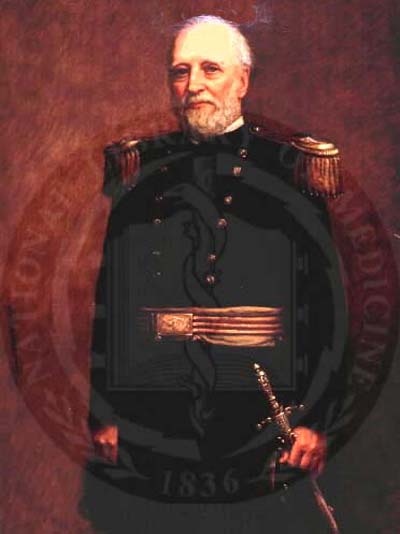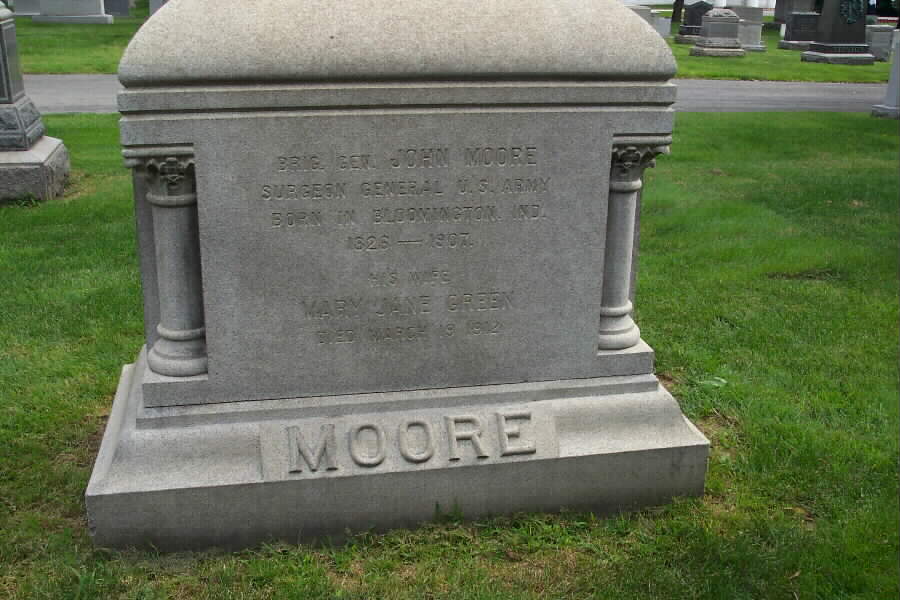Courtesy of the United States Army
JOHN MOORE (August 16, 1826 – March 18, 1907), Surgeon General, November 18, 1886 – August 16, 1890, was born at Bloomington, Indiana, the son of Garrett Moore and Catherine English. He attended Indiana State University where he was graduated with the degree of A. B. in 1845. After medical courses at the University of Louisville Medical Department in 1848-49 and at the medical department of the University of the City of New York in 1849-50 be graduated from the latter school in 1850. After one year internship in Bellevue Hospital and two years with the New York Dispensary he took the examination in 1853 for the army medical service and was commissioned as assistant surgeon on June 29 of that year.
His first station was Fort Myers, Florida, where be served until November 1856. He next was ordered to Fort Independence in Boston harbor where be stayed until July 1857, at which time he was detailed to duty with troops en route to Utah in connection with difficulties arising between the Government and the officials of the Mormon church. His station was at Camp Floyd, Utah, until October 1861, though in the meantime he saw field duty from August to October 1859, and from June to October 1860, in connection with Indian depredations. He was promoted to the grade of captain on June 29, 1858.
With the beginning of the Civil War he was brought east and assigned to duty in the Marine Hospital at Cincinnati, Ohio, where he served until August 1862. Having been promoted to the grade of major on June 11, 1862, he was transferred to the Army of the Potomac and assigned as medical director of the Central Grand Division. He held this position until February 18631 in the meantime participating with his division in the second battle of Bull Run, Antietam, and the disastrous attack at Fredericksburg. Promoted to the position of medica director of the 5th Corps in the Army of the Potomac he served in this capacity at the battle of Chancellorsville. His next assignment in June 1863 took him to the Department of the Tennessee as medical director, which position he held until November 1864. During his tenure of this office the troops under Rosecrans fought the campaign against Chattanooga with the battles of Chickamauga and Lookout Mountain, and General Sherman conducted his march upon Atlanta. From November 1864 to June 1865 Moore was successively medical director of the Army of Georgia and Tennessee and of General Sherman’s army in southern Georgia. With the close of hostilities he was assigned as medical director of the Military Division of the Missouri with station at St. Louis until November 1865, when he was transferred to Vicksburg, Miss., as medical director until August 1866. Meanwhile he had been given the brevet rank of Lieutenant Colonel on September 1, 1864, “for gallant and meritorious service in the Atlanta campaign,” had been made Colonel of volunteers on February 25, 1865, a commission he held for five months, and had been given the brevet rank of Colonel on March 13, 1865, “for faithful and meritorious service during the war.”
In the autumn of 1866 he was transferred to New York harbor where he served for two years at Fort Wadsworth and Fort Columbus. The years from 1868 to 1880 were passed mainly in New York City as attending surgeon and on various board assignments. During this tour of duty in New York he availed himself of a long leave of absence for travel in Europe. It was also broken by a short assignment to the office of medical director of the 1st Military District at Richmond, Virginia, in 1870, and by a year as medical director of the Department of Texas in 1875-76. In 1880 he was assigned to duty as medical director of the Department of the Columbia with headquarters at Fort Vancouver, Washington. On October 8, 1883, he was promoted to the position of Assistant Medical Purveyor with the grade of Lieutenant Colonel, and was transferred to duty in San Francisco where he served until 1886 when he was appointed Surgeon General.
During the latter days of the administration of Surgeon General Murray the various candidates for the succession were busy aligning their supporters and strengthening their claims for consideration. Colonel Baxter was the senior officer of the corps and Colonel Sutherland had the greatest number of years’ service. Major Huntington, well down the list, had served two Surgeon Generals as principal assistant and had edited with distinguished credit the last surgical volume of the Medical and Surgical History of the War of the Rebellion. These were apparently the leading candidates; Moore, a Lieutenant Colonel, was seventh in the lineal list and was one of the least insistent of the candidates. The appointment was delayed for three and a half months, during which time Colonel Baxter, as the senior officer, occupied the position of acting Surgeon General. A new political party had recently come into power and new influences were at work, so it came as a distinct surprise when President Cleveland appointed Moore to be Surgeon General with the grade of Brigadier General on November 18, 1886.
In addition to retaining Colonel Baxter as his principal assistant he brought into the office Major Charles R. Greenleaf and Major Charles Smart, forming a trio of strong and capable men who helped much toward the improvement of the medical service and toward the success of his administration. By a General Order No. 86, issued from the War Department on November 20, 1886, instruction in first aid was introduced through out the army. The instruction was directed to be by lecture and demonstration and reports of results achieved were required from the medical officers giving the instruction. Following and as a result of this order there appeared a succession of small manuals of first aid by medical officers of the service, usually combined with a manual of drill for the newly authorized Hospital Corps. The first of these manuals, which appeared early in 1888, was written by Lieutenant J. E. Pilcher, followed soon thereafter by those of Majors Heizmann, Hoff, Havard, and Woodhull and by that of Captain Dietz. The law authorizing the formation of the Hospital Corps was passed by Congress March 1, 1887 (24 Stat. 435), the corps to be filled by transfers of men from the line of the army, and Army General Orders No. 56 were issued August 11, 1887, promulgating rules and regulations for the government of the Hospital Corps. This was a truly great event in the history of the department. The corps as authorized and initiated has developed into the splendid corps of enlisted noncommissioned officers and privates of which the department is justly proud. On January 17, 1887, the Army and Navy General Hospital in Hot Springs, Ark., was opened with sixteen beds for officers and sixty-four for enlisted men. It was owing to General Moore’s insistence that the monthly sanitary report was made of practical value. The provision of Army Regulations, revised July 15, 1885, in regard to the sanitary report directed its transmission to the War Department by post commanders. Insistence upon this provision not only added to the quality of the reports but assisted materially in the sanitary improvements of the posts.
General Moore was popular with the medical profession at large. During his long tour of duty in New York City he had formed a wide acquaintance with the profession of that city. The cordiality of the regard in which he was held was manifested at a dinner given in 1887 by the New York Practitioners’ Society for him and the Surgeon General of the Navy. The dinner was a striking tribute, not only to the two honor guests but also to the interest of the civilian profession in the military branch. A similar interest was evident in the meetings of the military section of the Ninth International Medical Congress held in Washington later in the same year.
General Moore was retired, upon reaching the statutory age, on the 16th of August 1890. He continued his residence in Washington, where for years he maintained vigorous health and an active life. He was a large, broad-shouldered man with a powerful physique and a fine soldierly bearing. In his later years he developed arterio-sclerosis and an interstitial nephritis which caused his death at his home on March 18, 1907, in his eighty-second year.
His funeral from St. Matthew’s Church was notable for the attendance of high government officials. He was buried in Arlington Cemetery.
He was married in New York City on June 22, 1873, to Mrs. Mary Jane Dolan, widow of Michael F. Dolan of Roxbury, Mass. He was survived by his wife and one daughter, the wife of W. A. Thompson, an officer of the cavalry arm.
John Moore, surgeon, born in Indiana, 16 August, 1826. He entered the United States army as assistant surgeon in June, 1853, and, after serving in Florida and on the Utah expedition of 1857, was in the Cincinnati marine hospital in 1861-‘2. He was promoted surgeon in June of the latter year, and assigned to the Army of the Potomac as medical director of the central grand division, he became medical director of the Department and Army of the Tennessee in May, 1863, accompanied General William T. Sherman on his march to the sea and through the Carolinas, and received the brevets of lieutenant-colonel for the Atlanta campaign, and colonel for services during the whole war. He was made assistant medical purveyor, with rank of lieutenant-colonel, 8 October, 1883, and on 18 November, 1886, was appointed surgeon-general of the army, with the rank of brigadier-general.

Michael Robert Patterson was born in Arlington and is the son of a former officer of the US Army. So it was no wonder that sooner or later his interests drew him to American history and especially to American military history. Many of his articles can be found on renowned portals like the New York Times, Washingtonpost or Wikipedia.
Reviewed by: Michael Howard

